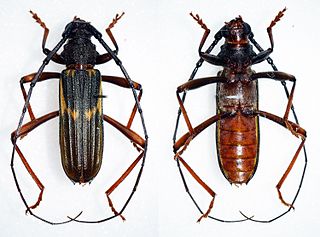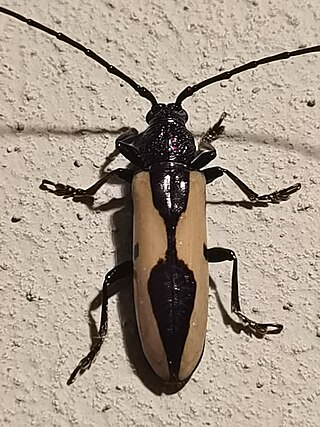
Bothriospilini is a tribe of beetles in the subfamily Cerambycinae, containing 11 genera which have a primarily neotropical distribution. The tribe was proposed in 1950 by Brazilian entomologist Frederico Lane as a member of the new subfamily Bothriospilinae, and with Bothriospila assigned as the type genus. The tribe is morphologically close to the tribe Torneutini, with which it has in common the same shape of the last abdominal segment, which is wide and largely braided in the female, as well as the anterior thigh cavities that are open from behind and the laterally open medial cavity.

Chlorida is a genus of beetles in the family Cerambycidae, containing the following species:

Mionochroma is a genus of typical longhorn beetles in the family Cerambycidae. There are more than 20 described species in Mionochroma, found in the Neotropics.

Criodion is a genus of Long-Horned Beetles in the beetle family Cerambycidae. There are about 11 described species in Criodion.

Poeciloxestia is a genus of longhorn beetles in the family Cerambycidae. There are more than 20 described species in Poeciloxestia, found in Central and South America.
Caperonotus is a genus of typical longhorn beetles in the family Cerambycidae. There are at least four described species in Caperonotus, found in Brazil, Peru, and French Guiana.
Odontocera is a genus of beetles in the family Cerambycidae, containing the following species:

Chlorida cincta is a species of beetle in the family Cerambycidae. It was described by Félix Édouard Guérin-Méneville in 1844. It is known from Mexico, Colombia, and Ecuador.
Chlorida costata is a species of beetle in the family Cerambycidae. It was described by Audinet-Serville in 1834. It is known from southeastern Brazil, Paraguay, Argentina, and Uruguay.
Chlorida curta is a species of beetle in the family Cerambycidae. It was described by James Thomson in 1857. It is known from French Guiana, northern central Brazil, and Ecuador.

Chlorida denticulata is a species of beetle in the family Cerambycidae. It was described by Buquet in 1860. It's known distribution is in Guyana, French Guiana, and Ecuador. Known host plants include Eperua rubiginosa, Ormosia paraensis, and Hevea guianensis.

Chlorida festiva is a species of beetle in the family Cerambycidae. It was described by Carl Linnaeus in his landmark 1758 10th edition of Systema Naturae. It is known from southeastern United States, Central America, South America, and the West Indies. Adult males produce (6E,8Z)-6,8-pentadecadienal, an attractant pheromone. In Puerto Rico the larvae are known to be leaf mining pests of mango crops.
Chlorida inexpectata is a species of beetle in the family Cerambycidae. It was described by Ubirajara Martins, Maria Helena Galileo and Francisco Limeira-De-Oliveira in 2011. The species epithet is derived from the Latin inexpectatus. It is known from Brazil.
Chlorida obliqua is a species of beetle in the family Cerambycidae. It was described by Jean Baptiste Lucien Buquet in 1852.
Chlorida spinosa is a species of beetle in the family Cerambycidae. It was described by Per Olof Christopher Aurivillius in 1887. It is known from Colombia, Bolivia and Peru. Adult males produce (6E,8Z)-6,8-pentadecadienal, an attractant pheromone.
Chlorida transversalis is a species of beetle in the family Cerambycidae. It was described by Jean Baptiste Lucien Buquet in 1844. It is known from Colombia.

Mionochroma aureotinctum is a species of beetle in the family Cerambycidae. It was described by Henry Walter Bates in 1870. It is known from Mexico, Panama, the Guianas, Peru, and Brazil.
Mionochroma ocreatum is a species of beetle in the family Cerambycidae. It was described by Henry Walter Bates in 1870. It is known from French Guiana, northwestern Brazil, Peru, Ecuador, and Colombia.
Sphallotrichus puncticollis is a species in the longhorn beetle family Cerambycidae. It is known from Nicaragua, French Guiana, Panama, Colombia, Costa Rica, Ecuador, and Peru. This species has subspecies, Sphallotrichus puncticollis robustus and Sphallotrichus puncticollis puncticollis.
Phespia cercerina is a species of beetle in the family Cerambycidae. It was described by Henry Walter Bates in 1870. It occurs in French Guiana, Brazil, Paraguay, and Peru.






